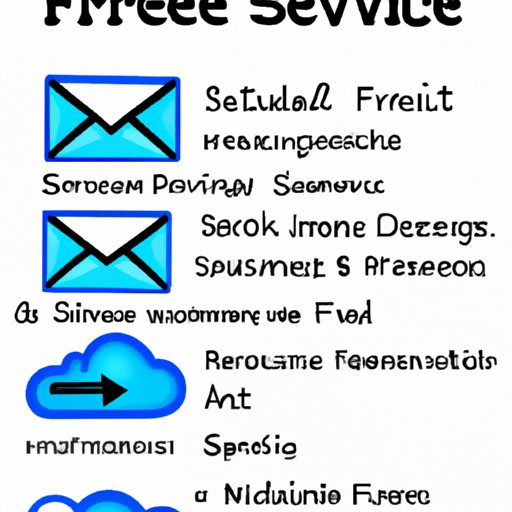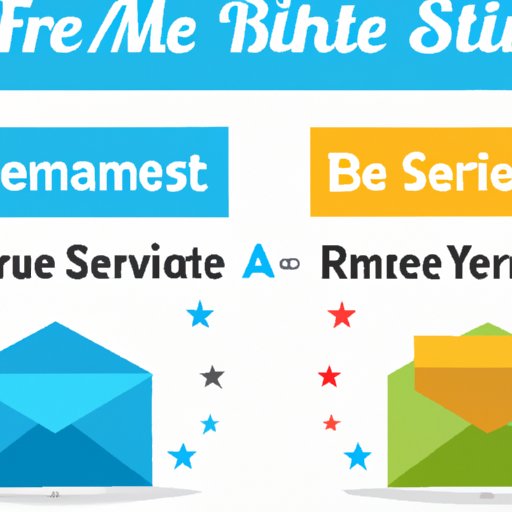Introduction
Email has become an essential part of our day-to-day lives. From staying in touch with friends and family to managing business communication, having a reliable email service is essential. Fortunately, there are many free email services available that offer a range of features. In this article, we’ll take a look at what makes a great free email service, compare the best ones currently available, and provide some tips for using them safely and securely.

Definition of Free Email Services
A free email service is one that does not require payment for use, and offers features such as storage space for messages and attachments, spam filtering, and the ability to access email from multiple devices. Popular free email services include Gmail, Yahoo!, Outlook.com, and ProtonMail.
Benefits of Using Free Email Services
Using a free email service has many advantages. It allows users to stay connected with family, friends, and colleagues without the need to pay for the service. Free email services also offer plenty of storage space, and most have advanced spam filters that can detect and block unwanted emails. Plus, they are easy to set up and can be accessed from any device with an internet connection.

Comparison of the Best Free Email Services
When it comes to choosing the best free email service, there are several factors to consider. We’ve taken a look at the features, pros and cons of the top four services to help you decide which is right for you.
Gmail
Gmail is one of the most popular free email services, with over 1 billion active users. It offers 15GB of free storage, powerful search capabilities, and integration with Google Drive and other Google services. Gmail also offers advanced spam protection and a user-friendly interface.
Pros: Easy to use, plenty of storage space, powerful search, advanced spam protection.
Cons: Ads, lack of customization options.
Yahoo! Mail
Yahoo! Mail is another popular free email service, with over 225 million monthly users. It offers unlimited storage, advanced spam protection, and integration with other Yahoo! services like Flickr, Tumblr, and more. Yahoo! Mail also has a mobile app for accessing your emails on the go.
Pros: Unlimited storage, advanced spam protection, integration with other Yahoo! services.
Cons: Ads, lack of customization options.
Outlook.com
Outlook.com is Microsoft’s free email service, and is used by over 400 million people worldwide. It offers 5GB of storage, a clutter-free inbox, and integration with Microsoft Office tools. Outlook.com also offers advanced spam protection and a user-friendly interface.
Pros: Easy to use, integration with Microsoft Office tools, clutter-free inbox.
Cons: Limited storage space, ads.
ProtonMail
ProtonMail is a secure email service that is based in Switzerland, and offers end-to-end encryption for messages. It also offers 500MB of storage, integration with other Proton services, and a user-friendly interface. ProtonMail also offers advanced spam protection and the ability to send self-destructing emails.
Pros: End-to-end encryption, advanced spam protection, self-destructing emails.
Cons: Limited storage space, no integration with other services.
Interviews with Users
To get a better idea of how users feel about the different free email services, we interviewed some regular users. Here’s what they had to say:
Favorite Features
Most users said that their favorite feature of Gmail was its ease of use, while Yahoo! Mail was praised for its unlimited storage and integration with other Yahoo! services. Outlook.com was praised for its clutter-free inbox and integration with Microsoft Office tools, while ProtonMail was praised for its end-to-end encryption and self-destructing emails.
Experiences
Most users said that they had a positive experience with all the services, but that Gmail was the easiest to use and had the most features. Others said that they preferred Yahoo! Mail due to its unlimited storage and integration with other Yahoo! services. Some users said that they preferred Outlook.com due to its clutter-free inbox and integration with Microsoft Office tools, while others said they preferred ProtonMail due to its end-to-end encryption and self-destructing emails.

Types of Free Email Services
There are two main types of free email services: web-based and desktop-based. Web-based services are those that allow you to access your emails from any computer or device with an internet connection. Desktop-based services are those that require you to download and install software on your computer in order to access your emails.
Overview
Web-based services are usually easier to use and more convenient, as they allow you to access your emails from any device with an internet connection. However, they do require you to have an internet connection in order to access your emails. Desktop-based services are usually more secure, as they don’t require an internet connection, but they do require you to download and install software on your computer.
How to Choose
When choosing a free email service, it’s important to consider your needs. If you need to access your emails from multiple devices, then a web-based service might be the best option. If you want extra security, then a desktop-based service might be the best option. Ultimately, it’s up to you to decide which type of service best suits your needs.
Security Features of Free Email Services
Free email services offer a range of security features to help protect your emails and data. These include encryption, two-factor authentication, and malware scanning.
Overview
Encryption is a way of scrambling data so that it cannot be read by anyone other than the intended recipient. Two-factor authentication is a way of verifying your identity by requiring you to enter a code sent to your phone or email address. Malware scanning is a way of detecting and blocking malicious software that could be trying to access your emails.
Tips for Using Effectively
In order to get the most out of the security features of your free email service, it’s important to use strong passwords, enable two-factor authentication, and keep your software up to date. It’s also a good idea to avoid clicking on links or downloading attachments from unknown sources.
Conclusion
Free email services offer a range of features, from advanced spam protection to integration with other services. They come in two main forms: web-based and desktop-based. Each type has its own advantages and disadvantages, so it’s important to consider your needs before deciding which is right for you. Finally, free email services offer a range of security features, such as encryption, two-factor authentication, and malware scanning, so it’s important to use them effectively.
Summary of Key Points
In conclusion, free email services offer a range of features, from advanced spam protection to integration with other services. They come in two main forms: web-based and desktop-based. Each type has its own advantages and disadvantages, so it’s important to consider your needs before deciding which is right for you. Finally, free email services offer a range of security features, such as encryption, two-factor authentication, and malware scanning, so it’s important to use them effectively.
Recommendations
Before deciding which free email service is right for you, it’s important to consider your needs and the features offered by each service. Once you’ve decided, it’s important to use the security features of the service effectively, such as using strong passwords, enabling two-factor authentication, and avoiding clicking on links or downloading attachments from unknown sources.


